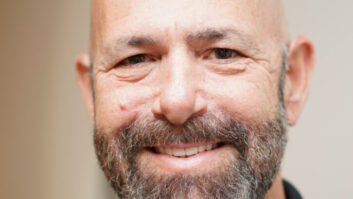Circuit City’s Alan McCollough is confident that, after two years of “state-of-the-art” training that resulted in equal performance by hourly and commissioned salespeople, the chain’s current all-non-commissioned sales force will “do a great job.”
The No. 2 CE chain, which has long been one of the most copied, respected and feared retailers in the business, sent shock waves throughout the industry when it announced in February that it was going to a non-commissioned sales format and fired 3,900 commissioned salespeople. (See TWICE, Feb. 10, p. 1.)
Circuit City’s commissioned sales approach has always been perceived in the industry as a key point of differentiation between the Richmond, Va.-based retailer and its chief rival, Best Buy, as well as Wal-Mart and other national chains.
The reverberations in the industry over the past few weeks have been many. Regional independents are uniformly pleased that they have been able to hire many former Circuit City salespeople. Rumors and conjecture about possible future changes have run rampant.
To set the record straight and outline the reasons for the strategy, Circuit City’s chairman/president/CEO McCollough spoke with TWICE by phone last Wednesday.
TWICE: Since your decision to drop commissioned salespeople, both suppliers and competitors have asked why, during the midst of the ongoing digital transition in CE, you’d drop your most knowledgeable employees?
McCollough: Something that makes us distinctive from our competitors is knowledge and the ability to communicate our product knowledge to our customers.
Over the past two years we have put together a state-of-the-art training system that allows us to train our folks online. Every one of our salespeople has their own Internet mailbox dedicated to training. We have delivered over a million training courses. One of the ways we were enabled to make this change is that we found a vehicle that allowed us to provide the knowledge they needed to take care of customers in an extraordinarily friendly way.
No one comes into any store and asks, “How do you pay your salespeople?” They only care if we have people who are able and capable. The customer wants knowledge and we think we have always done an extraordinary job in that area and we still think we do an extraordinary job of doing that. That confidence enabled us to make the change.
Specifically, what gave your company the opportunity to make the change now?
At the time of the announcement, our sales force was split. Forty percent of the people on our selling floor were paid hourly, while 60 percent were on commission. We have seen great evidence that when you take a good, qualified person, provide the right tools and set the right expectations, you get results. We spent over two years with this training program for both hourly and commissioned salespeople, and they did equally well. So this is about [product] knowledge for us, not about how we pay our people.
There has been some conjecture in the industry that your decision means that Circuit City will now de-emphasize big-ticket purchases. Is that accurate?
Absolutely not. When we removed appliances we needed the space to fill out the CE assortments that we wanted to be in. For instance at the time we weren’t in digital cameras and it was pretty obvious we needed to be there. It is now a very large part of the business. We weren’t in the game business, a key traffic driver in the consumer electronics business. We had no place to put it.
The impetus about dropping appliances was that, for starters it’s not a great business. There were a lot of CE categories that we didn’t have the space for. We decided to be a CE retailer first and foremost and would not do anything to jeopardize that area.
We believe it is our responsibility and our intention to carry the very best products and train folks in a way to effectively present those products. We need to match people who want entry-level product with those products, and match up those who want the most sophisticated products.
Speaking of store layout and a changing industry, flat-panel display sales are going through the roof. Are you planning to change your stores to reflect this trend?
That has been a good business and we expect it to continue. We really won’t talk about our intentions for display [of flat-panel sets] except to tell you that I think we have been pleased about plasma and LCD. With 42-inch plasma displays from prominent brands, consumers are willing to spend $4,000 to $5,000 and go higher. LCD’s been a great surprise — and people are willing to buy it too.
You can see in 300 of our stores last year we made a major investment in the TV business. We believe that TV will be the centerpiece of home entertainment for some time to come — frankly, not just flat-panel but many of the other near-flat technologies. The various technologies — LCoS, LCD, plasma, DLP — [will make] TV a critical part of the CE business for years. Just look at those 300 stores.
Are there any problems with HDTV returns? Also there has been talk that your mix in digital TV is changing. Have you made changes or are you planning changes in the near future?
We have not seen anything extraordinary in returns. Only talk I’ve heard is from product that we don’t carry, entry level flat-panel product that is outside of the major brands we sell. As for branded product, we are delighted to sell all we can. As for changes in our [HDTV] mix, we can’t and don’t talk about that.
How do you think the market for DTV set-top box converters will be handled by retailers?
In the end we think what the customer wants is the capability built into the TV set. The Dec. 19, 2002, agreement between the National Cable Telecommunications Association and the Consumer Electronics Association provided us the first step for that to happen, with Panasonic showing the [PHILA] product at CES. So I think that the real market is integrated sets, especially when you look at the FCC mandate that said that all digital over-the-air tuners have a timeline to 2006.
When you have to take that step, if you build in the digital cable functionality to the other components, circuitry for over-the-air HDTV signals, the additional cost is relatively modest.
We are more likely to see CE manufacturers moving aggressively to build in digital cable functionality into their sets alongside of the over-the-air digital tuner. That will interest consumers much more than a digital cable box that disables some of the features of the TV set.
Are you currently selling cable and digital cable boxes in certain areas of the country?
We are selling cable service in a few places, having the box provided by the operator. But they are still proprietary boxes. I’m not aware of any that are POD-enabled or multisystem enabled. We are assisting [consumers] in the lease of the boxes. It is not a meaningful [business] today. What will be meaningful is not how many cable boxes we can sell, but how quickly can we integrate digital cable functionality into a TV set because customers really don’t want another box.
This year, what are you looking at in terms of store counts?
You should expect that we will be aggressive in looking for opportunities to relocate stores. We have to move from older locations to the newer stores. But the real focus is how fast can we relocate. We said the target is 18 to 22 for this year. We have targeted 50 for next year.
In five years what type of retailer will Circuit City be? And today, what are your strengths? What are your weaknesses?
In five years I hope that we would be whatever the type of retailer the consumer wants us to be. One of the things we have focused on recently, that we didn’t focus on too well in the past, is refreshing stores, revitalizing our stores base. In particular where we relocate and build new stores so the great lengths to build in flexibility. Just like all of us couldn’t have predicted five years ago what will be popular now, we won’t be able to predict accurately what will be popular five years from now.













